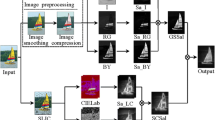Abstract
In recent years, a number of methods of salient object detection in images have been proposed in the field of computer vision. However, sometimes the shooting conditions are far from the ideal, and the unpredicted camera jitters significantly impair the quality of video sequences. In this paper, the salient objects are roughly detected from the keyframes of non-stationary video sequences with two main purposes. First, the removal of salient objects helps to estimate a motion in background more accurately. Second, a visibility of salient objects can be improved after stabilization of video sequence. In this sense, the fast generation of multi-feature approximate saliency map is required. Various fast techniques suitable to extract intensity, color, contrast, edge, angle, and symmetry features from the keyframes are discussed. Some of them are based on Gaussian pyramid decomposition. The Law’s 2D convolution kernels are applied for fast estimation of texture energy contrast and texture gradient contrast in particular. The experiments show the acceptable spatial saliency maps in order to obtain good background motion model of non-stationary video sequence.
Access this chapter
Tax calculation will be finalised at checkout
Purchases are for personal use only
Similar content being viewed by others
References
Borji, A., Cheng, M.-M., Jiang, H., Li, J.: Salient Object Detection: A Survey. http://arxiv.org/pdf/1411.5878.pdf (2014)
Itti, L., Koch, C., Niebur, E.: A model of saliency-based visual attention for rapid scene analysis. IEEE Trans. Pattern Anal. Mach. Intell. 20(11), 1254–1259 (1998)
Achanta, R., Shaji, A., Smith, K., Lucchi, A., Fua, P., Susstrunk, S.: SLIC superpixels compared to state-of-the-art superpixel methods. J. Latex Class Files 60(1), 1–8 (2011)
Li, X., Li, Y., Shen, C., Dick, A., van den Hengel, A.: Contextual hypergraph modelling for salient object detection. In: IEEE International Conference on Computer Vision (ICCV’2013), pp. 3328–3335. IEEE (2013)
Hou, X., Zhang, L.: Saliency detection: a spectral residual approach. In: IEEE Conference on Computer Vision and Pattern Recognition (CVPR’2007), pp. 1–8. IEEE (2007)
Guo, C., Zhang, L.: A novel multiresolution spatiotemporal saliency detection model and its applications in image and video compression. IEEE Trans. Image Process. 19(1), 185–198 (2010)
Le Meur, O., Le Callet, P., Barba, D., Thoreau, D.: A coherent computational approach to model bottom-up visual attention. IEEE Trans. Pattern Anal. Mach. Intell. 28(5), 802–817 (2006)
Zhuang, L., Tang, K., Yu, N., Qian, Y.: Fast salient object detection based on segments. In: International Conference on Measuring Technology and Mechatronics Automation (ICMTMA’2009), vol. 1, pp. 469–472. IEEE Computer Society (2009)
Liu, Z., Zou, W., Le Meur, O.L.: Saliency tree: a novel saliency detection framework. IEEE Trans. Image Process. 23(5), 1937–1952 (2014)
Favorskaya, M., Jain, L.C., Buryachenko, V.: Digital video stabilization in static and dynamic scenes. In: Favorskaya, M.N., Jain, L.C. (eds.) Computer Vision in Control Systems-1, ISRL, vol. 73, pp. 261–309. Springer International Publishing Switzerland (2015)
Ejaz, N., Mehmood, I., Baik, S.W.: Efficient visual attention based framework for extracting key frames from videos. Sig. Process. Image Commun. 28(1), 34–44 (2013)
Katramados, I., Breckon T.P.: Real-time visual saliency by division of Gaussians. In: IEEE International Conference on Image Processing, pp. 1741–1744. IEEE Press, New York (2011)
Laws, K.I.: Rapid texture identification. SPIE Image Process. Missile Guidance 238, 376–380 (1980)
Fu, K., Gong, C., Yang, J., Zhou, Y., Gu, I.Y.-H.: Superpixel based color contrast and color distribution driven salient object detection. Sig. Process. Image Commun. 28(10), 1448–1463 (2013)
Rosin, P.L.: A simple method for detecting salient regions. Pattern Recogn. 42(11), 2363–2371 (2009)
Favorskaya, M., Buryachenko, V.: Fuzzy-based digital video stabilization in static scenes. In: Tsihrintzis, G.A., Virvou, M., Jain, L.C., Howlett, R.J., Watanabe, T. (eds.) Intelligent Interactive Multimedia Systems and Services in Practice, SIST, vol. 36, pp. 63–83. Springer International Publishing Switzerland (2015)
Favorskaya, M., Buryachenko, V.: Video stabilization of static scenes based on robust detectors and fuzzy logic. Frontiers Artific Intellig Appl 254, 11–20 (2013)
MSRA10K Salient Object Database. http://mmcheng.net/msra10k/. Accessed 22 Dec 2015
IVRG—Images and Visual Representation Grow. http://ivrlwww.epfl.ch/supplementary_material/RK_CVPR09/. Accessed 22 Dec 2015
Auto-Detected Video Stabilization with Robust L1 Optimal Camera Paths. http://cpl.cc.gatech.edu/projects/videostabilization/. Accessed 22 Dec 2015
Cheng, M.-M., Mitra, N.J., Huang, X., Torr, P.H.S., Hu, S.-M.: Global contrast based salient region detection. In: IEEE Conference on Computer Vision and Pattern Recognition (CVPR’2011), pp. 409–416. IEEE Press, New York (2011)
Achanta, R., Hemami, S., Estrada, F., Süsstrunk, S.: Frequency-tuned salient region detection. In: IEEE International Conference on Computer Vision and Pattern Recognition (CVPR’2009), pp. 1597–1604. IEEE Press, New York (2009)
Perazzi, F., Krähenbühl, P., Pritch, Y., Hornung, A.: Saliency filters: contrast based filtering for salient region detection. In: IEEE Conference on Computer Vision and Pattern Recognition (CVPR’2012), pp. 733–740. IEEE Press, New York (2012)
Acknowledgments
This work was supported by the Russian Fund for Basic Researches, grant no. 16-07-00121 A, Russian Federation.
Author information
Authors and Affiliations
Corresponding author
Editor information
Editors and Affiliations
Rights and permissions
Copyright information
© 2016 Springer International Publishing Switzerland
About this paper
Cite this paper
Favorskaya, M., Buryachenko, V. (2016). Fast Salient Object Detection in Non-stationary Video Sequences Based on Spatial Saliency Maps. In: Pietro, G., Gallo, L., Howlett, R., Jain, L. (eds) Intelligent Interactive Multimedia Systems and Services 2016. Smart Innovation, Systems and Technologies, vol 55. Springer, Cham. https://doi.org/10.1007/978-3-319-39345-2_11
Download citation
DOI: https://doi.org/10.1007/978-3-319-39345-2_11
Published:
Publisher Name: Springer, Cham
Print ISBN: 978-3-319-39344-5
Online ISBN: 978-3-319-39345-2
eBook Packages: EngineeringEngineering (R0)




